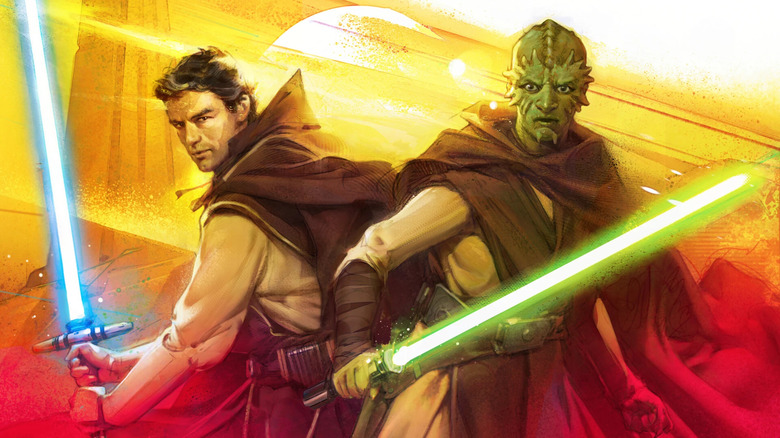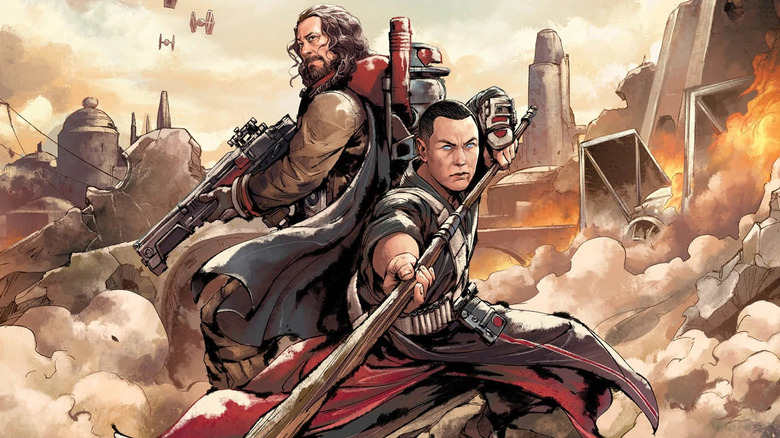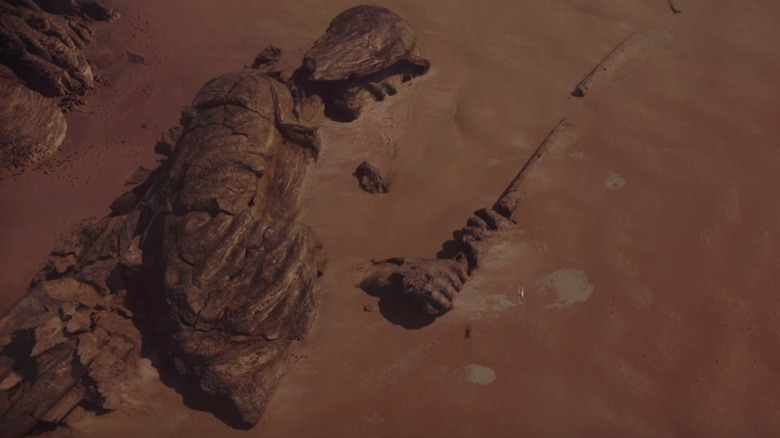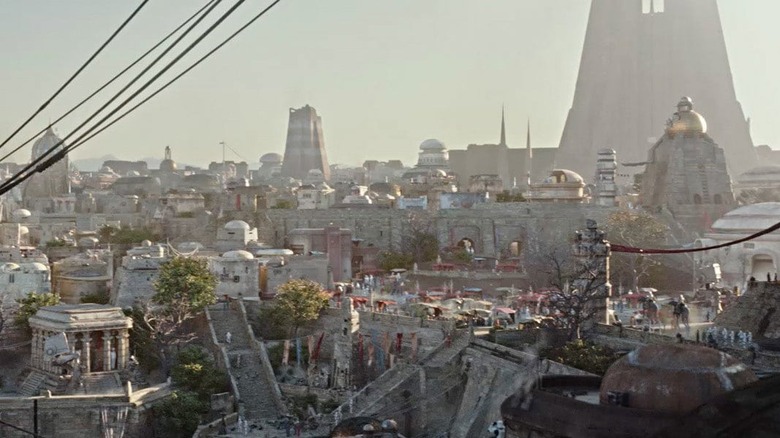Fans Of Rogue One Will Want To Dive Into Star Wars: The Battle Of Jedha
Spoilers for "Star Wars: The High Republic: The Battle of Jedha" by George Mann follow.
The publishing initiative from Lucasfilm that takes "Star Wars" back hundreds of years — "The High Republic" — continues apace with a new foundational story called "The Battle of Jedha." Though a print component of this will be coming out next month, it is primarily a full-cast audio drama from Del Rey. Written by George Mann, it picks up where the previous entries have left off. Set hundreds of years before the events of "The Phantom Menace" and a hundred or more years before the first phase of "The High Republic," the twin planets of Eiram and E'ronoh have been at war for ages. Independent of the Republic, their war starts to affect local space lanes and other planets, so Chancellor Mollo of the Republic tries to broker a peace. The young heirs of each planet find each other in a situation where they think they can bring peace and offer to marry each other.
Everyone thinks peace is imminent as "The Battle of Jedha" begins. The Jedi and the Republic organize for their final peace treaty to be signed on the neutral ground of Jedha for all the galaxy to see. Envoys from both Eiram and E'ronoh arrive in warships but are still willing to sign the treaty. Things go to hell quickly when a bomb goes off at the signing, killing the mediator — Morton San Tekka of the influential San Tekka family.
Anger foments and more explosions and assassination attempts occur as Jedha descends into chaos. Riots break out, a Jedi-killing leveler is unleashed, and the Path of the Open Hand — the organization that will transform into the villains of the first phase of "The High Republic" — have their hands in every pie.
After one of the ambassadors for the dueling planets is killed, both planetary delegations deploy troops to the surface of Jedha as a proxy battlefield for their war, with innocent civilians caught in the middle. The Jedi and other sects of Force religions fight to end the conflict and prevent Jedha's destruction.
Fans of "Rogue One: A Star Wars Story" will be excited to be able to learn more about the history of one of the most important locations in that film. We finally learn how Jedha City came to be known as "The Holy City."
Religious diversity in the Force
The aspect of this audio drama that I found the most fascinating was the religious diversity found on Jedha. In the "Star Wars" movies, the predominant religion in the galaxy felt like a binary. There was the Force and non-believers. And the Force itself had a binary between light and dark and that was it. But it makes sense to see a galaxy where different people interact with the Force in different ways. "Star Wars: The Clone Wars" and "Star Wars Rebels" have begun to expand that view of the Force. The Lasat people call the good aspects of the Force the Ashla, and the Bogan represents something else entirely. "Rogue One" gave us The Guardians of the Whills — which feature prominently in this story — and a hint that there were many religions represented on Jedha.
Now, thanks to "The Battle of Jedha" we get to see the full sweep of religions represented. From "The Church of the Force" to the "Brothers of the Ninth Door" and all points in between, we see so many of these sects arguing and bickering about the nature of the Force. As the "High Republic" looks to take us further back in time, it makes sense that these questions of religion take a front seat in the presentation of the universe.
The most interesting discussion comes between the beliefs of the Path of the Open Hand and the Jedi. At one point, a conversation between the Mother and Jedi Silandra Sho delves deep into this philosophical divide where there is a question of what "balance" means. For the Path of the Open Hand, any manipulation of the Force to save a life means the Force will balance itself by taking another life elsewhere. Every time the Force is manipulated for good, a bad thing happens elsewhere. To the Jedi, this is preposterous. But you can see where those who cannot manipulate the Force would find it easy to believe such a thing.
This creates a window into how the Jedi interact with other sects of Force believers and makes one realize they weren't the end all be all of the Force.
The Protector
One major component of the story is the Protector. Fans will recognize the Protector as the fallen statue of a Jedi, buried in the sands of Jedha outside the holy city. How did it fall? Was it a portent of things to come? This audio drama answers that question. We've seen it upright in some of the comic books of this phase, but "The Battle of Jedha" is what pushes the iconic statue of a Jedi over, literally.
Some in the story take this as symbolic and use it to bolster their beliefs about the utter fallibility of the Jedi. Some of the Jedi take it as a sad warning. In any case, if you're a fan of "Rogue One: A Star Wars Story" and want to learn more about the planet it takes place on, its history, and what was lost when Tarkin and Krennic unleash the Death Star's single-ignition laser blast against the Holy City.
The final accounting
I find that full-cast audio dramas are not my favorite way of ingesting "Star Wars" stories. I'd much prefer a book, a comic or a movie. That's not to say "The Battle of Jedha" is bad, I just realize it's not my ideal medium for "Star Wars." That being said, this was an intense story with a lot of interesting texture added to the "Star Wars" universe. It moves the story along, and the Battle of Jedha will undoubtedly be a lynchpin in the storytelling moving forward. It raises tantalizing questions about the inevitable future of the Path of the Open Hand as they make their way into transforming into the Nihil and it expands the gap between the Graf family and the San Tekkas.
As for the Jedi, it offers us hints of what the choices would be like in deciding whether or not to fight a war and how to get involved in a conflict with the ideals they have. It's messy and this might be one of the first steps the Jedi make that lead to the path of them becoming Generals in the Clone Wars.
The main thing I loved about this was how propaganda works and how you can fuel hate into riots. There is a lot of contemporary political commentary in here and it's wonderful to see it against the canvas of "Star Wars". It goes back to the roots of "Star Wars" in that way, and it's really a great thing to see. You can see the easily fooled starting riots just like on January 6th, based on lies and half-truths. It turns the stomach and makes you empathize with the Jedi, wondering what there can be done against such reckless hate.
For those who love audio dramas, the production is excellent, the voice acting is distinct and gives a true sense of character. They all live and breathe. It's exciting and funny, the sound effects and music are well-produced. I listened with my daughter, and she was utterly captivated for it. For those who prefer reading, the story waits for you to read it in February.
"Star Wars: The High Republic – The Battle of Jedha" is available now wherever you listen to audiobooks and the script will be released next month in print.



